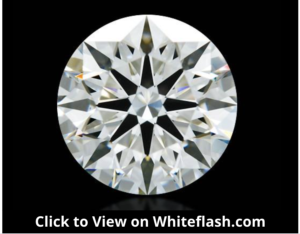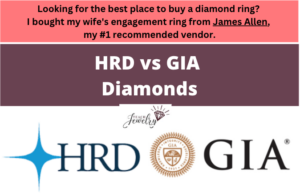
If you’re concerned about overpaying for a diamond, the solution starts with a report from a reliable grading institution.
You’ve likely seen ones graded by Hoge Raad voor Diamant (HRD), which is translated “High Diamond Council,” and the Gemological Institute of America (GIA).
For my wife’s engagement ring, I bought a diamond from James Allen that was graded by the GIA because they’re known as the most reliable and rigorous organizations in grading diamonds.
But let’s compare the HRD versus GIA so you understand their grading methods and which organization’s certification is right for you.
What are Diamond Grading Reports?
Diamonds grading show the buyer how the diamond is rated across its most important traits.
The price of a diamond is determined by its quality in many areas, namely the four Cs of color, cut, clarity, and carat.
If the seller told you a diamond weighed 1.5 carats, but it actually weighed 1.2 carats, you would overpay. The same is true for the other qualities. If you bought a diamond thinking it had a very good cut, but the cut was actually fair, you overpaid for a lower quality diamond.
Diamond certifying organizations validate the quality of a diamond. By selecting a diamond examined by a reliable gemologist, you’ll have confidence in the purchase.
Diamond grading reports are often referred to as “certificates.” There are differences between them, even though most consumers use them interchangeably. But some organizations like the GIA and HRD don’t promote their services using the term certificate.
They aren’t certifying the diamond. Instead, they are grading its qualities, so it’s called a report.
What to Know About HRD
HRD is headquartered in Antwerp, Belgium and was founded in the 1970s. It’s one of the premier diamond graders in Europe, and they benefit from their proximity to where many diamonds are sourced.
They offer a range of services for the diamond industry, including educational courses, equipment sales for examining diamonds, and screening and detection for laboratory versus real diamonds.
But the service they’re known for most by prospective diamond buyers is their grading reports. They provide a range of certification services that include analyzing natural, laboratory-grown, and treated diamonds.
The examination process features the following steps:
- Determine the diamond’s weight
- Check if it’s natural or lab grown
- Measure its height and diameter
- See if it fluoresces
- Grade its color
- Identify any inclusions
- Grade its cut

This checklist is turned into a grading report, which shows the potential buyer all the essential information about the diamond so they have an idea of what it’s worth.
While the HRD is well-regarded throughout Europe, this reputation doesn’t translate to the United States. Some in the industry consider their standards looser than many U.S. certifying organizations.
That means if you were to send a diamond to the HRD and some of the most popular graders in the U.S., you could often end up with different results.
What to Know About the GIA
The GIA is the most regarded institution for certifying diamonds in the U.S. They’re an independent nonprofit that provides educational resources about gems of all kinds and is credited with developing the four Cs.
It’s important to know the GIA, as well many of its peers, don’t determine the value of a diamond. Instead, they provide an objective report detailing its features. The price is then set by the market based on those qualities.
For example, if the GIA grades a diamond as having an excellent cut, it will sell for a higher price than a diamond with the same qualities, except a good cut.
The grading process involves professional gemologists first determining whether it’s a real or lab-grown diamond. It’s then graded along the four Cs and checked for any clarity-enhancements.
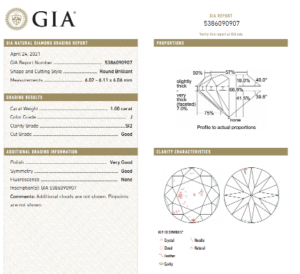
From there, gemologists grade its cut by assessing its facets, dimensions, and degree of brilliance. Lastly, they place it on a scale to determine its carat weight.
The results are compiled into a grading report.
The GIA is considered the most reliable, consistent organization that grades the qualities of diamonds. If you want the highest degree of confidence in a diamond’s carat, cut, color, and clarity, you should base it off the GIA grading report.
How are HRD and GIA Diamond Reports Different?
The confidence you gain from a diamond grading report is dependent on the reliability of the organization providing the exam. That’s why it’s not enough for a diamond to be certified by any institution. You should only buy one graded by a credible one.
The Rapaport Diamond Trading Network conducted a study where they sent the same 10 diamonds to six labs to assess the consistency of the grades: the GIA, IGI, HRD, EGL USA, EGL Israel, and EGL Hong Kong.
Overall, they found the GIA the strictest in their grading standards and the HRD the fourth strictest. The HRD was ahead of only EGL Israel and EGL Hong Kong. Many in the industry don’t place a premium on those organizations compared to the GIA and AGS.
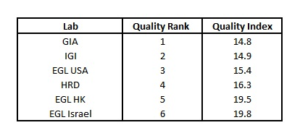
We’ll now explore the differences you should expect in the specific sections of HRD and GIA grading reports.
Carat
Carat isn’t referring to the diamond’s size. Instead, it’s a unit of weight equivalent to 200 milligrams. Both the GIA and HRD are known to give accurate assessments of a diamond’s carat weight because it’s an objective measurement.
No matter who is weighing it, the weight of the diamond isn’t up for debate when it’s placed on a scale.
Cut
The cut of a diamond refers to how its faces are cut and positioned, as well as its polish, depth and symmetry. Cut is the most important factor in how well a diamond reflects light. If you’re looking for a diamond with strong brilliance, choose one with a quality cut.
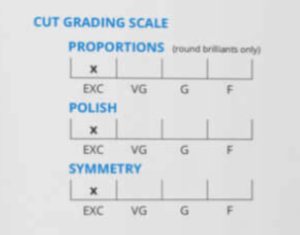
The HRD grades a diamond’s cut on a scale from poor to excellent. It includes three subcategories:
- Proportions: the degree of fire and brilliance
- Symmetry: the alignment and shape of facets
- Polish: the smoothness and overall condition of a diamond’s surface
GIA reports also take a diamond’s proportions, symmetry, and polish into account in grading a diamond’s cut. One difference is GIA reports list its symmetry and polish separate from the cut grade, while in HRD reports, it’s a subsection.
Some say the HRD is known to be less strict in how it grades cut.
In the assessment of 10 diamonds by Rapaport, there were three instances where the GIA and HRD graded cut differently. In two of those instances, the HRD graded it one level higher. This means that all else being equal, the buyer would’ve paid more based on the HRD grade.
Color
A diamond’s color grade refers to whether it’s colorless or has tints of brown or yellow. Diamonds closer to the colorless end of the scale are more valuable.
Both the GIA and HRD use a color scale of D (colorless) to Z (strong amounts of yellow).
As a general rule, some in the industry say you can expect the HRD to grade diamonds one color grade higher. For example, if the GIA determined a diamond should earn an H color grade, the HRD could give it a G.

In the Rapaport study, three of the 10 diamonds received different color grades. In two instances, the HRD scored it one grade higher. In the other instance, the GIA scored it one grade higher.
Others in the industry have performed similar tests and found the HRD averages two color grades higher.
This affects the buyer in the same way as cut. If you purchase a diamond believing it’s a G color, but it’s actually an H, you will have overpaid.
Clarity
Clarity refers to the presence of inclusions, or flaws, in a diamond. They can take many forms, including:
- Feathers
- Chips and indented naturals
- Cavities
- Twinning wisps
Inclusions, especially ones visible to the naked eye, decrease the value of a diamond because it distorts its appearance and brilliance.
The GIA and HRD have different grades for clarity but each measures the same criteria. The GIA uses the following clarity scale:
- Flawless
- Internally flawless
- VVS1
- VVS2
- VS1
- SI1
- SI2
- I1
- I2
- I3
The HRD uses the following scale:
- Loupe-clean
- VVS1
- VVS2
- VS1
- VS2
- SI1
- SI2
- P1 (Piqué)
- P2
- P3
In the Rapaport study, there were four instances where the HRD graded the diamond one clarity grade higher than the GIA. This is in line with others in the industry, where the consensus is you can expect the GIA to be one grade stricter grading clarity versus the HRD.
The consequence of this inconsistency is the buyer paying more for the HRD diamond because it earned a higher clarity grade.
Format
The format of an HRD and GIA grading report are similar, but if you place them side by side, you’ll notice a few differences.
The first is the order of information. On HRD reports, the left panel shows its color, clarity, and cut grades, including a chart of its proportions, polish and symmetry.
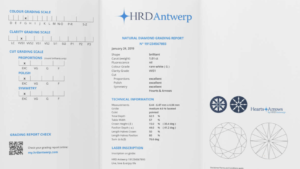
The left panel of a GIA report has its report number, shape and cutting style, measurements, and grades across the four Cs. The charts explaining the color, clarity, and cut scales are on the right panel.
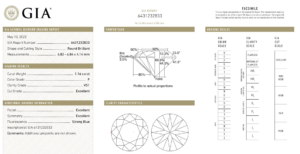
HRD reports provide a more clear representation of the diamond’s proportions by labeling each of the ratios like its table depth and width and crown height.
On a GIA report, the proportions are labeled on the diamond but it doesn’t include the name of the ratio.
Overall, both reports are reader-friendly and guide you through understanding the diamond’s qualities.
It doesn’t require expertise to comprehend them, but you may find yourself referencing the scales or searching for the ideal ratios for its measurements.
How do GIA and HRD Certifications Impact the Diamond’s Price?
The reason it’s important to purchase a diamond from a reliable grading institution is because the certification impacts its final sale price.
If an inconsistent gemologist grades the diamond with higher grades than it otherwise would have earned, the buyer pays the price.
For example, this GIA diamond from Whiteflash, a leading online diamond retailer, costs $7,904. It has the following grades from the GIA:
- Carat: 1.04
- Cut: Excellent
- Color: H
- Clarity: VS2
If the same diamond had been sent to the HRD, those studies indicate it may have received the following grades:
- Carat: 1.04
- Cut: Excellent
- Color: G
- Clarity: VS1
A diamond with those qualities from Whiteflash is listed at $9,063.
That means a different grade could cost the buyer 15 percent.
So why wouldn’t retailers send all their diamonds to be graded by the HRD, if they can command a higher price?
While the HRD is considered the standard in Europe, and many diamonds found there come with an HRD certificate, it’s not as common to find an HRD diamond from a large retailer in the U.S.
The reason is because the GIA has a strong reputation, and many buyers limit their choices to their certification.
“Choosing the right certification for your diamond is akin to selecting a guardian for its value; it’s a decision that upholds the diamond’s integrity and your investment. The GIA’s steadfast commitment to accuracy and the HRD’s renowned European standards both serve as pivotal touchstones in the journey of a diamond from the earth to the heart.” — Chuck Harris, Gemological Expert, Teach Jewelry
How do HRD and the GIA Compare to Other Certificates?
If you’re browsing diamonds at an online or in-person jeweler, it likely has diamonds graded by HRD, the GIA, and others in the industry such as:
- International Gemological Institute (IGI)
- European Gemological Laboratories (EGL)
- Gemological Science International (GSI)
- Gem Certification & Assurance Lab (GCAL)
- American Gem Society (AGS)
Like a comparison between HRD and the GIA, each of these organizations are known for stricter or looser standards compared to the others. They also specialize in certain types of gems to help them stand out in the market.
For example, IGI is known for providing some of the best grading reports for lab-grown diamonds, which is a service the GIA eventually started offering.
In the United States, GIA and AGS diamonds are popular. They’re both known for their rigorous standards and have established themselves as leaders in the field of gem science.
Should You Buy an HRD or GIA Diamond?
We recommend buying a diamond graded by the GIA and AGS, but if you buy an HRD diamond, ensure its quality matches what’s on the report.
You may get the same grades on a diamond from the GIA and HRD, but you risk a different color, clarity, or cut grade that could result in overpaying.
The average consumer has a difficult time distinguishing between the qualities in a diamond. To the naked eye, adjacent colors, clarities, and cuts look similar.
That’s where the work of a professional gemologist comes in. They can verify its qualities so it’s sold at a fair price.
Take the time to examine diamonds online with high-quality images or in-store, and always ask to see the accompanying GIA report.
Q&A Section on HRD vs. GIA Certifications
Q1: How does the diamond grading process by organizations like GIA and HRD contribute to the overall transparency of the diamond market?
A1: Diamond grading by reputable organizations such as the GIA and HRD enhances market transparency by providing a standardized and objective assessment of a diamond’s qualities. This allows consumers to make informed decisions and compare diamonds on a like-for-like basis, which can help prevent fraud and misrepresentation in the industry.
Q2: Are there specific diamond cuts or shapes where the difference in grading standards between HRD and GIA becomes more apparent, and why?
A2: The grading standards for cuts such as round brilliants are generally well-established and consistent due to their popularity and the volume of historical data. However, for fancy cuts like marquise, pear, or heart shapes, the difference in grading standards between HRD and GIA may be more pronounced because the assessment of these shapes can be more subjective, and the standardization is less rigid.
Q3: Besides the four Cs, what additional factors might a buyer consider when choosing between an HRD-graded and a GIA-graded diamond?
A3: Buyers might also consider factors such as fluorescence, which can affect a diamond’s appearance under different lighting conditions, the diamond’s provenance or ethical sourcing information, and specific gemological characteristics that might be unique or particularly desirable to the buyer, such as the presence of certain types of inclusions that could have collector interest.
Q4: How do GIA and HRD address the grading of synthetic or lab-grown diamonds, and is there a notable difference in their approach?
A4: Both GIA and HRD provide reports for lab-grown diamonds, but the terminology, grading scales, and disclosure practices may vary. For instance, GIA uses specific wording to distinguish lab-grown diamonds from natural ones and may have different grading scales for color and clarity in synthetic diamonds. It’s important for consumers to understand the nuances of these reports when comparing lab-grown diamonds.
Q5: What advancements or technologies are GIA and HRD investing in to improve the accuracy and reliability of their diamond grading reports?
A5: Organizations like GIA and HRD continually invest in research and technological advancements such as high-resolution imaging, spectrometry, and machine learning to improve the precision of their grading. These technologies help in identifying treatments, synthetic stones, and subtle quality factors that can influence the grading process.
Q6: How might market trends, such as the rising popularity of colored diamonds, influence the grading standards and practices of GIA and HRD?
A6: As colored diamonds become more popular, GIA and HRD may adapt their grading standards to provide more detailed and nuanced information about color characteristics. This might include comprehensive reports on color origin (natural vs. treated), secondary hues, and color distribution, which are crucial for assessing the value of colored diamonds.
Q7: Is there an appeal for HRD certifications in markets outside of Europe, and how does it affect international diamond trade?
A7: HRD certifications are respected globally, and their reports carry weight in many international markets, especially in countries with close trade ties to Belgium. However, the predominance of GIA in the global market means that HRD-certified diamonds may be less familiar to some consumers, potentially impacting their resale value and liquidity outside of Europe.
Q8: For a consumer interested in both quality and investment potential, how does the choice between HRD and GIA certifications affect the long-term value of a diamond?
A8: The long-term value of a diamond can be influenced by the perception and demand for certification from different organizations. GIA is generally recognized worldwide for its rigorous standards, so a GIA-certified diamond may retain its value better and be more easily resold. However, an HRD-certified diamond of equivalent quality might be purchased at a more competitive price, potentially offering a higher return if the market perception of HRD were to improve in the future.

Jacob Clarke
Jacob Clarke is the founder of TeachJewelry.com.
He earned an Applied Jewelry Professional Diploma from the Gemological Institute of America (GIA) and now brings you essential information about diamonds, settings, and more.
Jacob has consulted with leading jewelry brands, and his work has been cited in Clean Origin, Diamond Nexus and industry publications.
He's also a member of the International Gem Society.
He enjoys discussing jewelry with readers, so contact him with any questions at jacob.clarke@teachjewelry.com.

